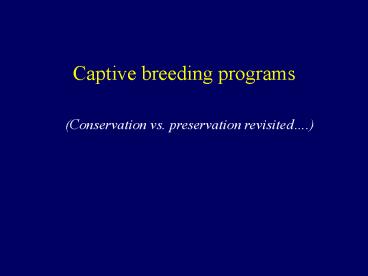Captive breeding programs - PowerPoint PPT Presentation
1 / 20
Title:
Captive breeding programs
Description:
... variability with that of founder/wild population(s) ... loss of wild populations through competition for mates, habitat captive-bred may be healthier ... – PowerPoint PPT presentation
Number of Views:2555
Avg rating:3.0/5.0
Title: Captive breeding programs
1
Captive breeding programs
(Conservation vs. preservation revisited.)
2
Purposes of captive breeding programs
- protection of threatened species (captive
maintenance) - habitat is completely lost
- threats to extinction cannot be overcome
- duration of captivity has irrevocably altered
species
3
Purposes of captive breeding programs
- conservation of threatened species
- objective to restore wild populations (no wild
individuals - left)
- objective to supplement wild populations that
have - declined or are threatened
4
maintain in permanent captivity
re-establish wild population
supplement wild population
minor major
consequences of genetic mismanagement
5
Stages in a captive breeding program
- decline of wild population, genetic consequences
- choice of founder population
- growing captive population
- maintaining captive population
- reintroducing individuals
- managing reintroduced population
6
Issues for captive propagation
- source of founder population(s)
- space requirements in captivity/space
availability in zoos - courtship/mating behaviors
- intrinsic rate of increase
- isolation of sub-populations
- availability of wild populations as sources of
new variation
7
Rules for captive propagation
- Founding the population - minimize genetic and
phenotypic change - collect random sample of founders
- collect data on locality, habitat of origin
- collect genetic data from founders
8
Rules for captive propagation
- Maintenance of the population
- maximize N and Ne (maximize sex ratio)
- maximize generation time (minimize generations in
captivity) - maintain equal family sizes
Lion average family size 1.65 variance in family
size 32.7 reduces effective popn. size to 8
9
Rules for captive propagation
- Maintenance of the population
- golden lion tamarin - founder population 242
individuals - 48 contributed to subsequent gene pool
- most of offspring (2/3) from single pair
10
Rules for captive propagation
- minimize loss of genetic variation
- maximize N and Ne (maximize sex ratio)
- maximize generation time
- maintain equal family sizes
- minimize behavioral changes
- minimize duration of captivity
- minimize inbreeding
- conduct pedigree analysis/management
- outcross population with new individuals
11
Rules for captive propagation
- manage demographics
- determine reasonable carrying capacity (note
effect on other taxa) - achieve carrying capacity rapidly
- stabilize population at carrying capacity
- maintain representation of age classes
- what to do with excess animals?
12
Rules for captive propagation
- Species Survival Plans (SSPs) for zoo species
- goal preserve genetic variation 90 of H over
100 years - list each individual in a studbook sex, sire
and dam, likely alternatives if uncertain
parentage - acquire data age-specific fecundity, mortality,
lifetime reproductive success, inbreeding - equalize reproductive contributions of each
individual - pair individuals of lowest mean kinship
- work with other zoos to share genetic material
- Limits to zoo taxa.
13
Rules for captive propagation
- Use 50/500 rule
- 50 parents for single generation
- Ne of 500 for long-term maintenance
- Conduct periodic genetic checking
- compare present population variability with that
of founder/wild population(s)
14
Problems with captive propagation
- Deliberate (artificial) selection
- for increased productivity fecundity, growth,
or both - for better type or traits (color, size)
- for tractability (handling, breeding season)
- problems with linkage of undesirable traits
15
Problems with captive propagation
- Deliberate (artificial) selection
- to remove genetic diseases
- Chondrodystrophy in California condor
- - lethal recessive trait hatchlings die
- - gene could be removed in one generation by
removing 77 of 146 condors - - careful breeding program was implemented
instead
16
Problems with captive propagation
- Accidental selection
- for increased productivity fecundity, growth,
or both - domestication select for fitness under captive
conditions - tends to homogenize differences among
sub-populations
17
Problems with captive propagation
- Absence of selection
18
General post-release problems
- lower fitness in wild
- domestication genetic and/or behavioral
- loss of variation
- increased fitness in wild
- loss of wild populations through competition for
mates, habitat captive-bred may be healthier - different development stages
19
General post-release problems
- lower fitness in wild
- increased fitness in wild
- Lake trout (Foster 1984)
- rapid early growth in hatchery
- young age at sexual maturity
- premature reproductive senescence
20
General post-release problems
- captive individuals may hybridize with wild
indivs. - pollution of wild genome
- loss of variation if lowered variance in captive
stock

